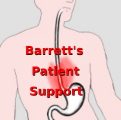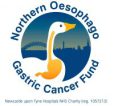PERSISTENT HEARTBURN, BARRETT'S OESOPHAGUS AND OESOPHAGEAL CANCER
This page replaces our Background Document with links to authoritative sources so that more recent statistics and other information can be more easily referenced.
The size of the problem of oesophageal cancer
Oesophageal (or gullet) cancer is the seventh most common cause of cancer death in the United Kingdom (2016). Each year in the UK around 9,000 people are diagnosed with oesophageal cancer, and over 8,000 die from it, according to Cancer Research UK. Only 15% of adult oesophageal cancer patients in England and Wales survive their cancer for five years or more. The 10-year survival is 12%. Oesophageal cancer mortality rates (which are adjusted to take account of an ageing population) increased in the UK between the 1970s and early 2000s, though in the past decade mortality rates have fallen in the UK, in line with the trend in many other developed countries.
Statistics for England are now included in the Get Data Out project that distinguishes cases by age, gender and type of oesophageal cancer.
It has been estimated that 950 UK lives could be saved each year if the rate of early diagnosis and outcomes of oesophago-gastric cancer (including stomach cancer) matched the best in Europe.
One prediction is that cases of oesophageal cancer will reach 11,700 in the UK by 2038-40
Across the UK, incidence rates are highest in Scotland and lowest in Northern Ireland. Within England there is a north-south divide, with incidence rates highest in the North West. In 2007, the Chief Medical Officer drew attention to a rise, over the previous two decades, in the incidence of oesophageal cancer (87% for men).
Adobe Acrobat document [350.2 KB]
Early Diagnosis
Early diagnosis makes a crucial difference to outcomes. Nationally, around a fifth of cases are only diagnosed in patients admitted to hospital as an emergency, with a corresponding tendency for them to be too late for curative treatment. Diagnosis at an early stage by endoscopy is particularly important, as it has been shown significantly to improve treatment outcomes compared to late stage cancers.
NOGCA Audit Report
The National Oesophago-Gastric Cancer Audit Report covers statistics for England and Wales and can be found here.
Statistics for countries within the UK
England:
7,500 new cases each year, and 6,400 deaths (2014-16). About 46% survive for one year, and 16% for 5 years or more. About 27% were diagnosed at an eary stage (stages 1 and 2) in 2016.
Scotland:
920 new cases annually and 840 deaths (2015-17). About 42% survive for one year or more, and 13% for 5 years or more. No data was available for diagnosis by stage from CRUK in May 2019.
Wales:
460 new cases and 440 deaths (2014-16). About 45% survive for more than one year, and 15% for 5 years or more. About 32% were diagnosed at an early stage (stages 1 and 2) in 2015.
Northern Ireland:
220 new cases and 200 deaths (2014-16). About 49% survive for one year or more and 19% for 5 years or more. About 29% were diagnosed at an early stage (stages 1 and 2) in the period 2011-15.
Types of oesophageal cancer
There are two main types of oesophageal cancer: squamous cell carcinoma (OSCC) and adenocarcinoma (OAC). OSCC (around a quarter (28%) of oesophageal cancers in the UK) tends to occur in the upper two thirds of the oesophagus and is associated with smoking and alcohol consumption.
OAC (about 70% nationwide; variable in some parts of England, but probably lower in Scotland) occurs mainly at the lower end of the oesophagus near the junction with the stomach, is not generally related to alcohol consumption but is associated with a pre-cancerous condition called Barrett’s Oesophagus (BO), persistent acid reflux and obesity.
The UK is reported as having the highest incidence of OAC in the world.
Gender differences
Around 7 in 10 oesophageal cancer cases in the UK are in men. For adenocarcinoma (the most common type of oesophageal cancer in the UK) in England the male:female ratio is even higher at 4:1.
Age Profile
More than 95% of oesophageal cancer cases are diagnosed in patients aged 50 years or more. Almost nine in ten cases in the UK are in people aged 60 and over, and incidence increases with age. The profile plateaus in the eighth decade.
OAC tends to occur in younger patients than OSCC, and its incidence is rising rapidly.
Barrett’s Oesophagus (BO), the only known precursor lesion for oesophageal adenocarcinoma, occurs earlier; 18% of those diagnosed with BO are under 50 years of age. The age profile for BO diagnosis is becoming progressively younger, and there are some reported cases progressing to adenocarcinoma in their 30s and 40s.
Why is Acid Reflux important?
Gastro-oesophageal reflux (GOR) is associated with the OAC, which represents 70% of cases of oesophageal cancer in the UK. It occurs when stomach contents (mainly acid but also bile) rise up into the oesophagus due to impaired function of the valve (lower oesophageal sphincter – LOS) between the oesophagus and the stomach. This may lead to a burning sensation known as heartburn, since the normal lining of the oesophagus is not designed to withstand acid and bile.
Gastro-oesophageal reflux disease (GORD) is a very common condition, with 30-40% of the UK population experiencing regular heartburn. In 2010, the number of prescriptions for heartburn / dyspepsia totalled 58 million at a cost of £336 million. There were approximately 50m prescriptions for PPI (proton pump inhibitor) medication (eg Omeprazole, Esomeprazole, Lansoprazole, Losec) to reduce stomach acid in 2013-14. These figures exclude the additional thousands of over-the-counter purchases.
Heartburn is sometimes combined in medical records with dyspepsia as an indigestion issue. Smoking and alcohol can relax the LOS and thereby contribute to GORD. Chocolate might have a similar effect. A hiatus hernia can also be relevant because part of the stomach comes to lie above the diaphragm ad the LOS is therefore unable to function properly. Obesity, and indeed some postural issues such as sitting on very low chairs after a meal, can lead to upward pressure that pushes stomach acid into the oesophagus. Stress can also increase GORD, as can a diet high in fatty food that takes longer to digest.
There is a high rate of reflux and obesity in the UK compared with Sweden, which may explain the UK’s rate of OAC being five times higher than that of Sweden. Most people who suffer from acid reflux, for a variety of reasons, will not develop complications, but there are estimated to be between 375,000 and one million people in the UK who have Barrett’s Oesophagus, that carries a cancer risk.
It is estimated that arond 10% of persistent heartburn sufferers will develop BO, and that 10% of those with BO will eventually develop cancer.
Barrett's Oesophagus as a cancer risk factor
Barrett’s Oesophagus (BO, also called Columnar Lined Oesophagus) is thought to be an acquired condition, though the cause remains unclear. An association between reflux of stomach acid (which is necessary for digestion and should normally be prevented from rising into the oesophagus by the LOS) and BO has been demonstrated by a landmark study.
The British Society of Gastroenterology (BSG) have issued Guidelines on the Management of Barrett’s Oesophagus. These have been published in Gut Journal vol 73, issue 6 in conjunction with NICE Guideline NG231 on monitoring and management of Barrett's Oesophagus and Stage 1 adenocarcinoma.
National Institute of Clinical Excellence (NICE) Guidelines on Dyspepsia and GORD (CG184) provide for patients with persistent, unexplained dyspepsia or reflux symptoms to have a discussion with their GP about referral to a specialist service.
The changed cells in the Barrett’s Oesophagus columns may resemble those of the stomach or intestine. If the latter, this is referred to as intestinal metaplasia (IM). In the USA, absence of a finding of IM has led to cases not being defined as Barrett’s; in the UK it has been shown that IM is not as relevant as was once thought since the malignant risk is similar whether IM is present or not. DNA abnormalities (which may be present with or without IM) are better predictors of malignant risk than IM.
Recent research in America has suggested significant genetic links. There is evidence that Barrett’s patients with a rhesus negative blood group are at a higher risk of progression to cancer. BO cases can cluster in families.
The length of the BO segments can be significant, with a higher risk of cancer in Barrett’s segments over 7cms in length. NICE Guidelines, mentioned above, indicate that a segment length of 1cm is normally the criterion for a diagnosis of Barrett's Oesophagus, and that intervals for surveillance practice vary from 2-3 years, or 3-5 years according to whether the segment is 3cm or longer.
The chance of developing cancer is often expressed as a risk for any one year (ie per patient year). Studies expressing the risk of BO patients developing adenocarcinoma have variously quantified this risk as low, between 0.22% and 0.5% per patient year. This is different from the lifetime risk that a patient faces. The risk is affected by the presence of dysplasia, a precursor condition for cancer.
Dysplasia is at present the most robust routinely used clinical marker of cancer progression in Barrett’s oesophagus. Currently, these cell changes can only be assessed after endoscopy with biopsy, where small pieces of tissue are removed and then looked at under the microscope. Histology (microscopy) reports may refer to ‘gastric type mucosa’ or ‘glandular epithelium of the gastric type’ rather than the more accurate ‘columnar-lined oesophagus’. Risk of cancer progression varies between grades of dysplasia:
a) Indefinite for dysplasia, or ‘atypia’ (unknown risk)
b) Low grade dysplasia (5.3% risk of adenocarcinoma in 1-8 years)
c) High grade dysplasia (50% risk of adenocarcinoma in 1-8 years)
The risk of Barrett’s Oesophagus progressing to oesophageal adenocarcinoma is reported in the medical literature as being between 0.3% and 0.6% per year, which translates to an overall lifetime risk of 7.5-12.5% depending on several factors including duration of the presence of Barrett’s. The lifetime risk may be as high as 25% in the unusual but reported situation of a patient living 50 years after Barrett’s diagnosis. The situation is complicated, especially from a patient’s point of view, by the fact that it is rare to know when Barrett’s Oesophagus first starts to develop, as distinct from when it is first diagnosed, although the relevant medical studies have all measured lifetime risk from the time of diagnosis. Risk of progression has been shown to be higher in male patients, concurrent smokers, patients with a family history of oesophageal cancer and long segment length. The presence of low grade or high grade dysplasia multiplies this risk. A specialist investigation and biopsies, followed by surveillance, are therefore important in this situation and may be indicators for intervention with endoscopic eradication therapy at a specialist centre.
It must also be noted that 90% of patients with non-dysplastic BO will have a constant cell type that will not progress to cancer, and they are more likely to die from an unrelated disease.
Barrett’s Oesophagus is present in the majority of all OAC cases but will not be seen if the tumour has arisen from a non-Barrett’s source or if a large tumour has over-grown the original Barrett’s.
The ASPECT trial, published in 2018, advocated taking Esomeprazole and aspirin to reduce the risk of developing cancer for those with BO, but more recent NICE Guidance (NG231) advises against offering patients aspirin for reducing the risk of developing cancer.
The UK Barrett's Oesophagus Registry (now closed) enabled a calculation to be made for the mortality rate for all oesophageal cancer in a group of patients already known to have Barrett’s Oesophagus and found mortality to be 11-fold higher than would otherwise be expected in a comparable group without Barrett’s. In relation to OAC it was 25 times higher.
Surveillance Endoscopy
Because of this risk of progression to cancer, it is important to diagnose Barrett's Oesophagus, and to monitor any development of dysplasia.
Patients diagnosed with BO are checked at intervals by surveillance endoscopy, in order to identify dysplasia, and treat it with endoscopic therapy when the disease is potentially curable. BSG guidelines recommend surveillance every 2-3 years, or 3-5 years according to whether the length of Barrett’s segment is 3cms or longer. The use of high-resolution endoscopy is recommended, to be carried out in a structured way for standardised measurement of the Barrett’s segment (the Prague classification). These endoscopy procedures require a lomger session than normal endoscopies.
The finding of dysplasia in BO needs a confirmatory repeat endoscopy with appropriate treatment at a specialist oesophageal cancer centre.
Cytosponge is used sometimes for BO surveillance, not least because of backlogs created during COVID.
Treatment
Barrett’s oesophagus with high risk features can now be treated in many cases by either destroying or removing the affected cells by endoscopy, without the need for surgery. In the UK, endoscopic therapy is now the standard care for Barrett’s oesophagus demonstrating high grade dysplasia (HGD) and early cancer.
Recently the British Society of Gastroeneterology (BSG) and NICE have approved these techniques for the treatment of persistent or confirmed low grade dysplasia. Techniques include Endoscopic Mucosal Resection (EMR), Radiofrequency Ablation (RFA) and, for small ‘islands’, Argon Plasma Coagulation (APC). Photodynamic Therapy (PDT) has been superseded by RFA and is seldom used now.
These techniques should be performed at centres where endoscopic and surgical options can be offered to patients. All patients with dysplasia or early cancer, for whom therapy is considered, should be discussed at the specialist Multi-Disciplinary Team meeting for oesophago-gastric cancer.
The National Oesophago-Gastric Cancer Audit is an important source of information about oesophageal and stomach cancers and high grade dysplasia (HGD), reflecting the recent trend towards endoscopic therapy. Surveillance was offered as a management option in a proportion of HGD cases despite the apparently high cancer risk.
Other symptoms of oesophageal cancer
Late symptoms of oesophageal cancer are difficulty or pain in swallowing food, food sticking in the gullet, and unexplained weight loss. In the presence of these symptoms, the cancer has often progressed to a stage when the opportunities for curative treatment are greatly reduced.
Better diagnosis of Barrett’s Oesophagus is an opportunity for making an impact on earlier diagnosis of oesophageal adenocarcinoma that is not available for many other types of cancer.





















